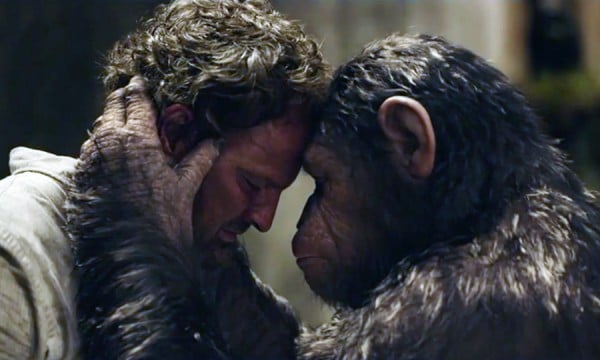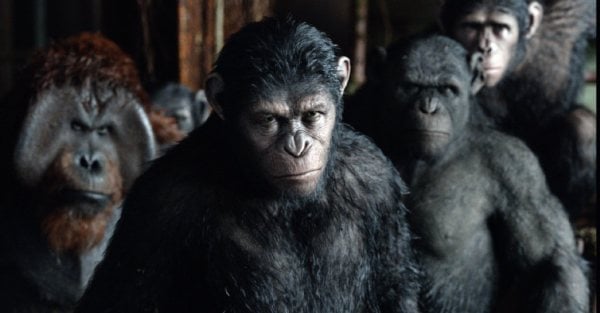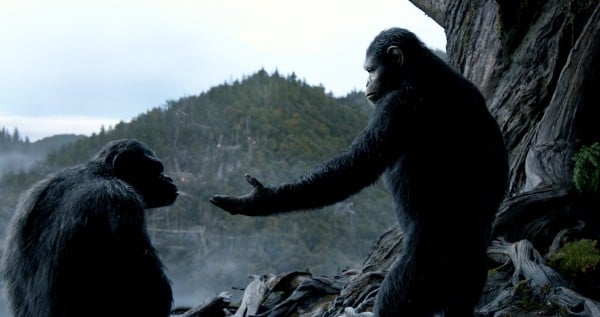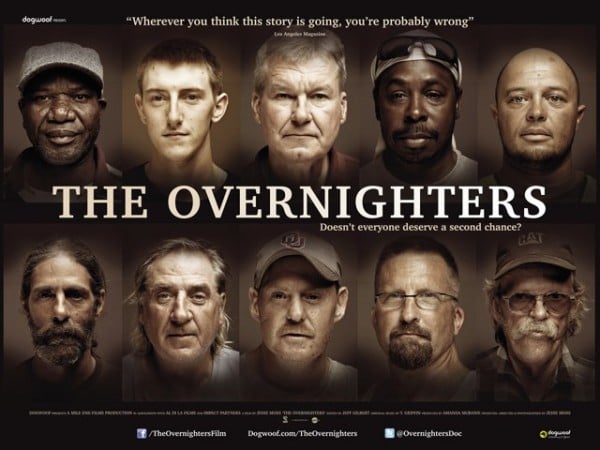If one of the unique characteristics of homo sapien sapien is that we are aware of our own existence and ask questions about ourself, another is that we wage war. 2011’s Rise of the Planet of the Apes chronicled sentient chimpanzee Caesar’s coming into self-knowledge and now Dawn of the Planet of the Apes takes the so-far inevitable next step in the story of intelligent lifeforms: armed conflict.
Dawn of the Planet of the Apes is the most successfully anti-war war movie in years.
Rather than make a heavy-handed case against war in any situation or create a flag-waving ode to combat bravery, the film explores the complexities of what makes man – or manlike creatures – take up arms against man.
And manages to be downright entertaining in the process.
As it starts, Caesar the Chimpanzee (Andy Serkis) is now the leader of a band of intelligent apes establishing a rudimentary civilization in the Muir Woods of California. He has a family he loves, represented by his nearly mature son Blue-Eyes (Nick Thurston), a home he has built, and a future in which to believe.
As the apes create their civilization, their human relatives lose theirs to a devastating plague. A remnant gathers in San Francisco, led by Dreyfus (Gary Oldman). The survivors are confused, desperate, traumatized, and eager for someone to blame.
Humanity meets ape when a work brigade hikes up to the woods to restart a hydroelectric dam. The deep mistrust that already exists between the species is only exasperated by a panicked act of violence. It is up to the human leader Malcolm (Jason Clarke) to forge bonds of trust with his ape counterpart in order to stave off war that will be devastating to both groups.
Just as Malcolm has trigger-happy, bitter, and frightened humans in his care, Caesar must contend with Koba (Toby Kebbell), a former victim of human experimentation that left him scarred inside and out.
The film sets up excellent parallels between Malcolm and Caesar, both of whom have families to lose and a small civilization depending on their efforts. After witnessing the implosion of the human race, Malcolm only wants to rebuild with his wife Elle (Kerry Russell) and son Alexander (Kodi Smitt-McPhee) while Caesar wants to be left alone to build his.
The 1968 original and its sequels were largely a metaphor for American black-white relations in the Civil Rights Era, but this film expands to consider any potential enemy, whether divided by race or religion or species or border.
By taking the audience inside the ape civilization, and making it care about it even though it is qualitatively “other” from human experience, the movie forces the audience to see mankind in a new light. The apes are decidedly not human. Yet they have a system of self-governance, something close to a monarchy. They have a rudimentary moral and legal code, the beginning of which is “Ape not kill ape.” Their language is developing, some of it vocal but most of it through sign language. A good deal of the ape dialog is in sign language, with subtitles, making this one of the few sign language films created for mass market.
Very differently than the older films, the chimpanzees, gorillas, and orang utans that populate this story are not merely human beings with more hair. They hoot and vocalize like simians. They move with agility when swinging from branches but clumsily on the ground. They go through the dominance displays and submissive responses that researchers tell us mark ape culture. None of this would be possible without the fantastic acting of Andy Serkis, who plays Caesar wholly convincingly. He is as well-rounded and sympathetic as any man onscreen, quite a miracle for someone acting another species via green screen and motion capture technology.
The action sequences are exciting, but equally complex as the general set-up. They certainly don’t glorify violence. They create the feeling that fighting is a great tragedy. Yet, they also don’t condemn warriors as victims, cowards, or hypocrites. Courage and honor exist in the humans ready to defend their homes just as in the apes resolved to defend theirs.
Confusion, misunderstanding, and ignorance block trust between the two tribes, made worse by the prejudice displayed by individuals on both sides.
However, the two sides are not so different at all. The greatest warriors fight for peace. Although both Caesar and Malcolm recognize there are things worth fighting for and outcomes worse than war, they both will go great lengths and risk their own lives to avoid a conflict that will bring havoc on those they love. And neither is so unwise as to overlook deceit and injustice in his own ranks nor nobility in the others’.
This is a nuance not often seen in movies about war, especially American movies made in the still-long shadow of Vietnam. Ultimately, the violence comes from elements within each group, and both are at fault. Caesar and Malcolm, like great leaders before them, must shepherd their people through conflict not of their choosing, trying to generate the best outcome for those who rely on them.
This is not a bumper-sticker movie, easily co-opted by warhawks or peaceniks, by pro-gun or anti-gun lobbies, by conservatives or progressives.
It’s more mature than that.
Conflict may be inevitable. Despite our best efforts, it may be unavoidable. When it starts, how do we execute it well, end it quickly, and maintain our humanity or ape-anity in the process?
Mankind is a long way from figuring this out, as the state of our world so depressingly demonstrates. At least this movie earnestly tries.
Dawn of the Planet of the Apes is rated PG-13, mostly for intense action and some violence. There are some moments of violence that may be disturbing to younger viewers. There is no sexuality and only very light language. Appropriate for teens and preteens who can handle action and some violence.
Read my review of 2011’s Rise of the Planet of the Apes.















